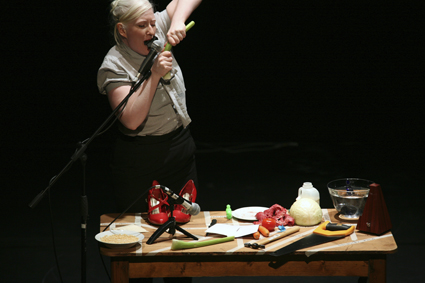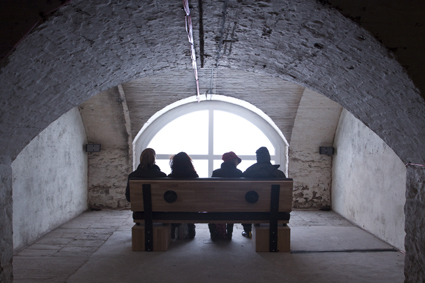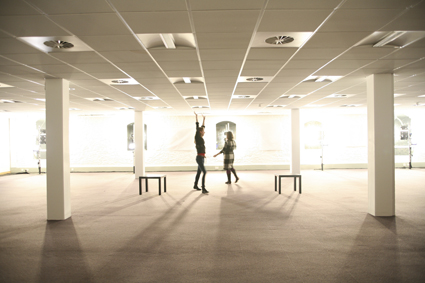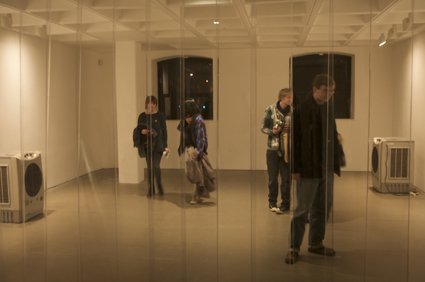 |
Jo Bannon, Foley photo Carl Newland |
jo bannon: foley
Bannon’s Foley takes place at a table amplified by microphones and cluttered with vegetables, water bowls, metronomes and raw meat, a toolbox which the artist treats—and mistreats—to produce sound effects. Audience members are prompted to join in, providing footfalls, smatterings of applause and gunshots (hence the firecrackers). This is Bannon’s tribute to the pernickety and vaguely comic world of foley artists, where grown adults pretend to be foraging animals, a corkscrew doubles as a sonic screwdriver (true story, Doctor Who fans) and trudging through custard powder is the only thing that properly sounds like footsteps on snow.
No animals or snowdrifts here, though: Bannon’s audio landscape has an urban film noir vibe, which she narrates in deadpan received pronunciation. It’s a tale of mysterious dames and shady customers lurking in alleyways that recalls the mischievous tone of Godard’s Alphaville, generic elements peppering the storyline simply because they must; people get beaten up because, in a noir, that’s what happens. The femme is fatale because, well…what other kind is there? In Bannon’s world everything is, deliciously, at the service of the sounds. It’s also intriguing that for all of her flailing around—screaming into a bowlful of water, repeatedly slapping a slab of rump steak into the microphone—Bannon maintains a clinical detachment, a procedural poise. The artist appears to be asking us to conclude our own story, to fill in our own gaps, the sound alone is what she provides. These are the components she’s willing to give us…no more, no less.
 |
Alex Bradley, Day For Night photo Oliver Rudkin |
alex bradley: day for night
There are several other works at the festival distinguished by starving one or more senses so as to expand others: sparse experiences where the viewer’s own body is the catalyst, the storyteller, the conduit. In Day For Night by Alex Bradley you sit on a bench in a basement of the Colston Hall, faced with nothing but an opaque half-moon window. A surround-soundtrack of treated guitar noise (barely recognisable as such) comes and goes in long washes of frequencies both within and beyond hearing range. The sub-bass pulses occasionally send geiger counter crackles through the bench and vibrate your backside and spine in a disconcerting way. But the principle requirement is that you must watch, focusing patiently on the window as it shifts, almost imperceptibly, from bright daylight to night-time gloom—complete with projected streetlamps and car headlights peeping through the venetian blinds—and back again. It’s accumulative, a little urban tone poem that condenses the day and speaks of roadworks beyond the bedroom window, wasted hours and cold evenings hidden inside the house, spoilt for me only by the over-effusive explanations of the venue staff: “You sit here. It’s 17 minutes long. It’s a loop. You watch it go from day to night. It’s dark now but it’ll get light later. It’s about bunnies.” (Well, maybe not the last one, but you get my drift…)
 |
Rod Maclachlan, Exchange photo Carl Newland |
rod maclachlan: exchange
Exchange by Rod Maclachlan is similarly concerned with light and dark. A pair of participants is sent into a large space wearing flexible bands around their ribcages; the rise and fall of their breathing alters the light levels in the room. In this incarnation Exchange features an impressive rig of blazing hot lights (and the angry buzz of resistors is a powerful additional presence) but the full effect suffers by not quite responding with the symbiotic speed or precision you’d hope for. Even so it’s great fun, and the lights I’m linked to project directly out of the windows on Arnolfini’s upper level, adding a pleasingly extrovert edge to the experience, announcing your respiration across Bristol’s Harbourside.
 |
Teresa Margolles, Aire photo Carl Newland |
teresa margolles: aire
But for me the most affecting of all these engineered, ‘heightened’ spaces is Teresa Margolles’ Aire, a room that, on first sight, looks like an empty gallery where Arnolfini staff have accidentally left two oversized humidifiers hanging around. These devices are, in fact, circulating a very particular type of water vapour around the room—a clue to its provenance lies in the ominous legend printed next to a clear plastic curtain isolating Aire from the rest of the exhibition: “THE AIR IN THIS GALLERY IS SAFE TO BREATHE” which, as a friendly reassurance, ranks right up there with “YES! OUR RESTAURANT IS NO LONGER INFECTED.”
Margolles has, in fact, infused the room with water used to wash corpses prior to autopsy at a morgue in Mexico City. It’s been disinfected, of course…but that simple information, that implication of death, hangs in the air. Now, you can approach this with disgust or reverence, or any number of fleeting feelings, and I spend a lot of time in Aire shifting from emotion to emotion. There’s so much to do in this empty room. What do you feel? You can consider the sheer number of bodies that pass through a Mexico City morgue (largely thanks to drug laws that future generations will point and laugh at, much as we point and laugh at the Elizabethans' attempted cures for the plague) and the stories that this vapour transmits, the curtailed lives it has touched.
You can picture those bodies, en masse, standing in the room with you, blank-eyed, naked, vaguely perturbed by being asked to participate in an artwork, pissed off at not being allowed to truly rest in peace. You can imagine that you smell the queasy cleanliness of a hospital (which is ridiculous, but smell it I surely do) and recall every time you’ve hung around waiting for a friend or loved one in some green-tinted ward. You can think of the journey that liquid has taken, the unlikeliest hop from a Y-section on a Mexican corpse to the cosy middle class milieu of a Bristolian arts centre. You can fight off superstitious revulsion at the molecules fizzing in your lungs, and where they’ve been. You can breathe in and out, deep and protracted breaths, communing uselessly with the dead, because they are dead and gone, and what good can you do for them now? You can look out of the window at the dark street beyond, perfunctory mechanical traffic on a frosty West Country night, feeling what a morgue worker feels when they emerge outside on a fag break; marvelling at the tiny differences between the living and the dead. For something so simple, Aire is a truly complex thing. It’s a quantum piece of work, gloriously indeterminate—in that depending upon how you look at it, it completely changes its behaviour.
Inbetween Time Festival of Live Art and Intrigue: Jo Bannon, Foley, Arnolfini, Dec 3; Alex Bradley, Day For Night, Colston Hall, Dec 2-5; Rod Maclachlan, Exchange, Arnolfini, Dec 2-4; Teresa Margolles, Aire, Arnolfini, Dec 1-Feb 6; Dec 1-5, Bristol UK
Our coverage of the 2010 Inbetween Time Festival is a joint venture between RealTime and Inbetween Time Productions
Timothy X Atack is a writer, composer and film-maker based in Bristol UK. He is a member of Sleepdogs and the band Angel Tech. He and Tanuja Amarasuriya, as Sleepdogs, presented The Dead Phone in the 2010 Inbetween Time program. www.timatack.co.uk
© Timothy X Atack; for permission to reproduce apply to [email protected]








 back
back